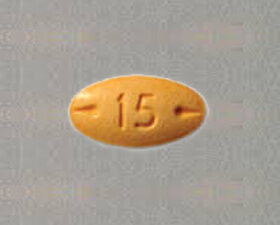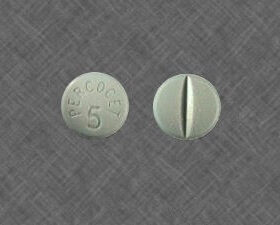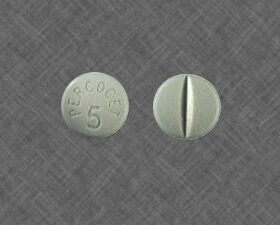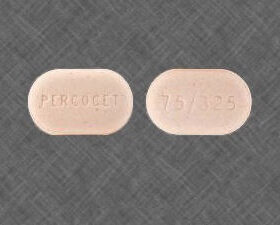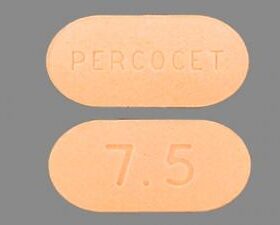- Your cart is empty
- Continue Shopping

Shop
Buy Percocet Online

What is Percocet?
Percocet is a type of opioid pain medication that requires a prescription and is formulated with oxycodone and acetaminophen. Oxycodone is an opioid analgesic that works to relieve moderate to severe pain. Acetaminophen is a mild pain reliever that enhances the effects of oxycodone.
Percocet comes in tablet form in various strengths, usually ranging from 2.5 mg oxycodone with 325 mg acetaminophen up to 10 mg oxycodone with 650 mg acetaminophen. It is prescribed by doctors to treat acute moderate to severe pain, such as after surgery or an injury.
The oxycodone component provides potent pain relief by attaching to opioid receptors in the brain and spinal cord. Meanwhile, acetaminophen serves to enhance the effects of oxycodone and add an extra layer of analgesia. This allows the oxycodone dose to be lowered while maintaining effective pain relief.
Buy Percocet online safely & conveniently. Explore our trusted pharmacy for authentic drugs. Fast shipping & secure transactions. Order Percocet now to get same-day delivery. Percocet is intended for short-term use only and carries significant risks if used improperly or for extended periods. It has a high potential for addiction and dependence. The combination medication is prescribed when the benefits are thought to outweigh the risks for the patient in the clinical judgment of the prescriber.
Percocet Medical Uses
Percocet is a prescription opioid medication that contains a combination of oxycodone and acetaminophen. It is approved by the U.S. Food and Drug Administration (FDA) for the relief and management of moderate to severe acute pain when an opiate analgesic is appropriate.
Percocet is typically prescribed for short-term use to manage pain after surgery or an injury. It can also be prescribed for other painful conditions, such as cancer pain, that cannot be adequately managed with non-opioid analgesics.
The oxycodone component relieves pain by binding to and activating opioid receptors in the brain and spinal cord. This blocks pain signals from being sent and perceived by the brain. The acetaminophen acts as a non-opioid pain reliever and fever reducer.
Percocet Dosage Details
Percocet tablets come in four dosage strengths:
- 2.5 mg/325 mg
- 5 mg/325 mg
- 7.5 mg/325 mg
- 10 mg/325 mg
The dosage amount depends on the severity of pain being treated. The typical starting dosage for pain is one tablet every 6 hours as needed.
The lowest effective dose should be used. Adults usually start at one tablet every 6 hours, but the dose may be increased as directed by a doctor. Doses over 10 mg/325 mg per tablet should only be taken under medical supervision.
Side Effects of Percocet
Percocet can cause several common side effects, even when taken as prescribed. These may include:
Nausea – Feeling sick to your stomach or vomiting are common side effects of percocet, especially when first starting the medication. Taking percocet with food can help minimize nausea.
Drowsiness – Percocet can make you very sleepy and slow your breathing rate. Combining Percocet with alcohol or other drugs that cause drowsiness can be very dangerous.
Constipation – Like other opioid medications, Percocet often causes constipation by slowing digestion. Staying hydrated, eating a high-fiber diet, and maintaining physical activity can help prevent opioid-induced constipation. If needed, talk to your doctor about taking a laxative while on Percocet.
Warnings Associated With Percocet
Percocet contains oxycodone, an opioid pain medication that carries serious risks and is not recommended for long-term use. Here are some important warnings to consider before taking Percocet:
Dependence and addiction: Percocet has a high potential for dependence and addiction, even when used as prescribed. With prolonged use, tolerance develops and users may require higher doses to achieve the same effect, increasing dependence.
Respiratory depression: High doses of Percocet can cause slowed or stopped breathing, which can lead to coma or death. Risk increases when combined with alcohol, antihistamines, and other CNS depressants.
Accidental overdose: Misuse or abuse of Percocet, especially when combined with other substances, greatly raises the risks of accidental overdose and death. The risk is especially high in those with no tolerance.
Use only as directed: Percocet should only be used exactly as prescribed by a doctor. Never take extra doses without medical supervision.
Avoid alcohol: Combining Percocet and alcohol is extremely dangerous and can be fatal. Alcohol enhances the sedative effects of Percocet.
Pregnancy risks: Use of Percocet during pregnancy can cause severe and life-threatening withdrawal symptoms in the newborn baby. Infants born to mothers taking Percocet may be physically dependent and suffer neonatal abstinence syndrome.
Overdose
Overdose of Percocet is potentially life-threatening and requires immediate medical care. The most serious symptoms of Percocet overdose include:
Severe respiratory depression – Slowed or stopped breathing can lead to a lack of oxygen. This causes the skin, fingernails, and lips to turn blue or purple (cyanosis). Lack of oxygen may also lead to brain damage, organ failure, coma, and death.
Pinpoint pupils – The pupils become very small, sometimes just a pinpoint in size.
Loss of consciousness – The person is unable to stay awake and alert.
Extreme drowsiness – The person is very sleepy and cannot stay awake.
Cold, clammy skin – The skin feels damp and cool to the touch.
Limp muscles – The muscles are very relaxed, loose, and have no tone.
Slow heartbeat – The heart rate becomes dangerously slow. This can lead to low blood pressure, organ failure, and death.
Withdrawal Symptoms
Stopping Percocet suddenly after taking it for an extended period can lead to withdrawal symptoms. Percocet withdrawal occurs when someone dependent on the drug abruptly stops taking it. The body has become accustomed to functioning with Percocet, and when it is removed, the body goes into shock.
Some common withdrawal symptoms include:
- Anxiety
- Sweating
- Insomnia
- Muscle aches and pains
- Runny nose
- Nausea and vomiting
- Diarrhea
- Tremors
- Cravings

